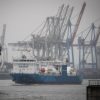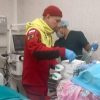
There is concern that the two TSMC factories in China, including this one in Shanghai, above, may be seized. Taiwanese soldiers are always on alert for Chinese aggression, which may affect the supply of the world’s microchips for phones and other devices
Credit: Qilai Shen/Corbis Historical
Days after Joe Biden’s inauguration, 15 Chinese warplanes flew sorties off the coast of Taiwan, crossing the midpoint of the 80-mile strait that separates the island from the Asian mainland. It was the biggest show of strength from Beijing over Taiwan in several months, a timely reminder that China still considers the democracy and its 24m people part of its territory.
Taiwan has long been a source of political tensions between China and the West. But in recent years it has become a source of economic and cybersecurity fears too.
The island has become the world’s microchip factory, the biggest single producer of the semiconductors that sit in iPhones, cars and telecoms networks. Its chip foundries – known as “fabs” – are the world’s most advanced, with manufacturers in the West struggling to keep up. As the US and China have been locked in an escalating technology war, the future of the island is an increasing concern.
“What happens if the Chinese should, inadvertently or on purpose, become engaged in a military conflict in Taiwan?” says Paul Triolo of the Eurasia Group. “You’re talking about the potential to disrupt massively that global supply chain for leading electronic companies.”

A total of 20 Chinese fighter jets have entered Taiwan’s air defence identification zone recently
Credit: SOHAIL SHAHZAD/EPA-EFE/Shutterstock
Little more than three decades ago, the US and Europe dominated semiconductor production, accounting for around three-quarters of manufacturing, against roughly a quarter in Asia. Even the UK had a strong manufacturing base. Today, that ratio has flipped. Taiwan, followed by Korea, China and Japan in that order, all outstrip the US, with Europe retaining a handful of specialised fabs.
The figurehead of that movement has been Morris Chang, a Chinese-born son of a government official who moved to the US to study in 1949, the same year Mao Tse-tung established the People’s Republic of China. After a career at Texas Instruments, one of the companies that built America’s semiconductor industry, Chang missed out on the chief executive job in 1983.
The Taiwanese government, about to emerge from decades of martial law and desperately seeking to modernise its economy, enlisted Chang and in 1987 public money helped set up Taiwan Semiconductor Manufacturing Corp, known today simply as TSMC.

A Taiwanese soldier waves a flag during a drill in Hsinchu military base ahead of the Chinese New Year holiday
Credit: SAM YEH/ AFP
The brainwave that Chang built the company on was that as microchips became smaller and more complicated to make, companies would look to outsource their production. Computer processors, the brains of electronics, are prohibitively capital intensive to manufacture, requiring machines that can each cost tens of millions of dollars. The silicon transistors that make up chips have become impossibly small. The factories required to make them now cost billions to build.
“Morris Chang saw that opportunity,” says Nathan Brookwood, a veteran industry analyst at Silicon Valley consultancy Insight 64. “Things have played out in a way that has helped him tremendously. Back in the Eighties, you could put together a factory for maybe $25m or $50m. Today, factories are costing $5bn (£3.6bn).”
In Britain, however, any ambitions to manufacture silicon have been small compared to those pursued in Taiwan. While Britain has enjoyed success with semiconductor design companies, such as Arm in the 2000s and Graphcore more recently, there are few businesses working on the process of building chips using lasers and chemicals in foundries.
Arm, the UK’s biggest chip success, makes the blueprints for semiconductors, and does not manufacture them itself. The biggest players are in South Wales, with IQE, which builds chips at its factory in Cardiff, and Newport Wafer Fab, which was founded in 2017.

An ARM Holdings Plc Cortex-A15 MPCore processor
Credit: Bloomberg News
Slowly the Government has recognised Britain is lagging behind. A £44m state investment in Wales’s silicon industry has given prospects a small boost, with hopes the cluster could ultimately employ 3,000 people, while Newport Wafer Fab is hoping to raise another £50m from investors this year to expand its operations, though it will remain dwarfed by TSMC.
Progress in chip manufacturing is measured in nanometres, the size of a chip’s transistors. At the end of the Nineties, 94 companies were capable of making the cutting edge 180nm chips, such as those in the 2000s’ PlayStation 2; 24 of those were American, just nine were Taiwanese.
The processors in today’s latest iPhones two decades later use 5nm chips. Only two manufacturers – TSMC and Korea’s Samsung – have mastered production. Intel, the last remaining major US-based manufacturer, is still struggling with the previous generation, even as TSMC moves ahead with 3nm.
Chang stepped down as chief executive in 2018, at the age of 86. To date, the rise of the company has been seen as a boon for the electronics industry, rather than a problem. Companies such as Arm, the British microchip design company, have been built on companies like Apple using its architecture and paying TSMC to build bespoke chips.
Taiwan became a convenient part of the global supply chain. Processors could be designed in the West, built by TSMC, and shipped to Shenzhen, where gadgets were assembled. The trade war between Donald Trump’s America and an increasingly confident China, however, has changed that balance.

Employees put on clean suits before entering the wafer FAB of Semiconductor Manufacturing International Corp in Shanghai, China on 18 February, 2011.
Credit: Qilai Shen/Corbis Historical
“The political tensions and the intelligence tensions, it makes us take a second look at Taiwan, and its relationship to China, its nearness to China,” says James Lewis, a former US state department negotiator at the Centre for Strategic and International Studies.
“What if China wakes up in a bad mood one day and decides to simply try to seize Taiwan?”
US concerns about Taiwan, says Lewis, are not only that the West relies on it as the world’s chip factory, but that China does too. The Trump administration used American leadership in parts of chip design and production to choke Chinese companies, particularly Huawei, as part of an effort to reduce their influence abroad and to demonstrate power in trade talks.
Triolo says Taiwan has effectively been put in the middle of the “blue” and “red” supply chains of the US and China. “They would prefer not to have its companies forced to choose between the US and China. There’s a huge market in China for them.”
For now, the blue chain appears to be winning. TSMC has been forced to stop supplying Huawei, since it uses American equipment, and the Chinese company has been cut off from high-end chips. Many fear, however, that the Trump administration overplayed its hand. The less access China has to Taiwan’s chips, made with American equipment, the more incentive it has to build a home-grown alternative, a project it is pursuing with gusto.
Semiconductor industry in numbers
China’s own manufacturing potential is expected to climb from 15pc of global capacity to 24pc at the end of the decade. Last week, SEMI, an industry group, wrote to the Biden administration warning that continued export controls against Chinese companies would undermine US manufacturers and incentivise foreign competitors.
Concerns are also growing about Chinese espionage in Taiwanese factories, or, in an extreme case, that Beijing may simply seize two TSMC factories that exist in China.
The US and China’s reliance on Taiwanese chips may be uneasy, but it is also stabilising. In the same way the nuclear arms race and the Cold War theory of mutually assured destruction protected both the US and the Soviet Union, mutually assured dependence on TSMC has meant neither side being willing to harm the other.
“It’s a potential point of tension, but on the other hand, there is such dependence that you have to be very careful,” says Triolo.
That interdependence may now be fraying. The US, as well as China, is trying to ease its reliance on the island nation. Last year, TSMC announced plans to build a $12bn fab in Arizona, a move believed to come with heavy subsidies. A recently passed national defence bill allows billions in incentives for US chip production, although where the money comes from is yet to be decided.
China is yet further behind, but has shown no signs of giving up. “They are making massive investments in semiconductor manufacturing on the mainland, says Brookwood. “It’s just a matter of time.”
Taiwan’s chip prowess has put it in the middle of an uneasy stalemate between the world’s superpowers. That may not last.






















































Свежие комментарии